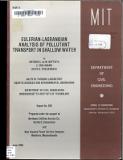| dc.contributor.author | Baptista, Antonio E. de M. | en_US |
| dc.contributor.author | Adams, E. Eric | en_US |
| dc.contributor.author | Stolzenbach, Keith D. | en_US |
| dc.date.accessioned | 2022-06-13T13:11:33Z | |
| dc.date.available | 2022-06-13T13:11:33Z | |
| dc.date.issued | 1984-06 | |
| dc.identifier | 296 | |
| dc.identifier.uri | https://hdl.handle.net/1721.1/143037 | |
| dc.description | Prepared under the support of Northeast Utilities Service Co., Hartford, Connecticut and New England Power Service Company, Westboro, Massachusetts. | en_US |
| dc.description.abstract | A numerical method for the solution of the two-dimensional, unsteady, transport equation is formulated, and its accuracy is tested. The method uses a Eulerian-Lagrangian approach, in which the transport equation is divided into a diffusion equation (solved by a finite element method) and a convection equation (solved by the method of characteristics). This approach leads to results that are free of spurious oscillations and excessive numerical damping, even in the case where advection strongly dominates diffusion. For pure diffusion problems, optimal accuracy is approached as the time-step, At, goes to zero; conversely, for pure-convection problems, accuracy improves with increasing At; for convection-diffusion problems the At leading to optimal accuracy depends on the characteristics of the spatial discretization and on the relative importance of convection and diffusion. The method is cost-effective in modeling pollutant transport in coastal waters, as demonstrated by two prototype applications: hypothetical sludge dumping in Massachusetts Bay and the thermal discharge from Brayton Point Generating Station in Narragansett Bay. Numerical diffusion is eliminated or greatly reduced, raising the need for realistic estimation of dispersion coefficients. Costs (based on CPU time) should not exceed those of conventional Eulerian methods and, in some cases (e.g., problems involving predictions over several tidal cycles), considerable savings may even be achieved. | en_US |
| dc.publisher | Cambridge, Mass. : Ralph M. Parsons Laboratory, Aquatic Science and Environmental Engineering, Massachusetts Institute of Technology, Dept. of Civil Engineering | |
| dc.relation.ispartofseries | Report / Ralph M. Parsons Laboratory, Aquatic Sciences and Environmental Engineering ; no. 296 | |
| dc.relation.uri | https://hdl.handle.net/1721.1/60596 | |
| dc.title | Eulerian-Lagrangian Analysis of Pollutant Transport in Shallow Water | en_US |
| dc.identifier.oclc | 11982213 | |
| dc.identifier.aleph | 309263 | |
